©
2004 Jeff Matthews & napoli.com
Neapolitan
culture (3), New Year's
 At
9 o' clock this morning all was quiet. An hour earlier, hordes of very
tired people were still driving around, generally wending their way
back home after having stayed up all night to see in the New Year. There
were two large public parties sponsored by the city in Naples last night:
one was in Piazza Plebiscito, the spacious square in front of the royal
palace; the other was in the recently reopened Piazza Dante about a
mile from the first one. The celebration at Piazza Plebiscito was the
one they have every year—fireworks, music, lots of year–end
noise. The festivities at Piazza Dante, however, were billed as the
celebration “for intellectuals,” whatever that is supposed
to mean. Perhaps they stood around and discussed what kind of values
are manifested by blowing off fingers with shoddy, homemade “cherry
bombs”. (In Naples, however, they use the whole orchard.) At
9 o' clock this morning all was quiet. An hour earlier, hordes of very
tired people were still driving around, generally wending their way
back home after having stayed up all night to see in the New Year. There
were two large public parties sponsored by the city in Naples last night:
one was in Piazza Plebiscito, the spacious square in front of the royal
palace; the other was in the recently reopened Piazza Dante about a
mile from the first one. The celebration at Piazza Plebiscito was the
one they have every year—fireworks, music, lots of year–end
noise. The festivities at Piazza Dante, however, were billed as the
celebration “for intellectuals,” whatever that is supposed
to mean. Perhaps they stood around and discussed what kind of values
are manifested by blowing off fingers with shoddy, homemade “cherry
bombs”. (In Naples, however, they use the whole orchard.)
I stayed
home and peeped out the window, from where one could see a massive display
of private fireworks: sparklers, sky-rockets, bombs and just plain nasty
incendiary devices going off from balconies. No one goes into the street.
It starts gearing up at about five minutes to midnight and carries on
until about one o’ clock in the morning. Depending on the weather,
the resulting smoke and haze from all the fireworks may or may not dissipate
quickly. Last night there was moist air with absolutely no wind and,
thus, by 20 minutes past midnight, you could barely make out buildings
100 yards away. All you saw was each additional flash as another round
was pumped into the gloom. Happy New Year.
Lentils
It is New
Year's. have spent the last hour or so examining the lentil—yes,
the common lens esculenta. I never understood why Neapolitans
go on a lentil binge at this time of year. It’s because the lentil
resembles a coin—I am here repeating what unregenerate lentophiles
tell me—and if you gorge yourself on them at the beginning of
the New Year, it bodes well for you; that is, you can expect lots of
little metal lentils—commonly known as coin of the realm—to
come your way. (You have a special reward stored up for you in Paradise
if you can say “metal lentil” five times really fast.) I
have now eyeballed lentils—even with a magnifying lens (hence
the name lens esculenta—they look like a lens…lenses?…lensi?…esculenta
means "edible")—and they still look like little beans to me. OK,
a little convex on one side (which maybe means they are concave on the
other side, but I’m not sure—I failed fabatopographics,
the study of the description of beans. I majored in music in college),
but, essentially, it’s a funny-looking bean. I don’t get
it.
Pernacchio;
Marotta, G. (2), Oro di Napoli (l')
I find
this in an English-language paper morning paper:
| The
finding has been of particular interest, as orangutans have long
been thought to be loners, leaving little possibility for creating
culture. Yet researchers found that at one site all orangutans
gave a Bronx cheer before going to sleep… |
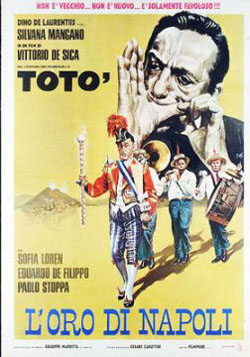 The
part about the “Bronx cheer” drew my attention. I, for one,
say “hear! hear!” to our orangutan cousins, the “oran
utan” of the Asian jungles, in their strivings towards our own
more advanced cultural habits. To that end, I offer this information. The
part about the “Bronx cheer” drew my attention. I, for one,
say “hear! hear!” to our orangutan cousins, the “oran
utan” of the Asian jungles, in their strivings towards our own
more advanced cultural habits. To that end, I offer this information.
Neapolitans,
like everyone else, commonly lament that things are not as good as they
used to be. For one thing, water. In the old days, drinking water in
Naples was a cold and pure experience, as refreshing as falling into
a snowbank in Heaven. Second, bread. Convoys of panisti (breadsteaders?)
still make weekend forages to the outlying areas, looking for El Doughrado,
the village fabled to bake bread the old-fashioned way—in a brick
oven fired by wood. Third, the topic of this brief attempt at interspecies
cultural aid and the final bit of damning evidence that things ain't
what they used to be: they say that there is no one left who can sound
a 'pernacchio' good and true.
The pernacchio
. This unvoiced trill or buzz made by protruding the tongue between
the lips and forcibly expelling air—possibly using the palm or
back of the hand as an aid to increase back–pressure and, hence,
amplification, is a common acoustic token (hereafter referred to as
a 'sound') of disapproval, contempt, derision, disapprobation, odium,
dislike, dissent, disdain, scorn or contumely. In some parts of the
United States it is called 'a Bronx cheer'. The general English term,
however, is 'raspberry' and it is one of the few examples of so-called
Cockney Rhyming Slang to find its way into common use throughout the
English speaking world. The complete phrase is 'raspberry tart,' a rhyme
with the common English term, now considered vulgar, for the sound produced
by flatulence and which the 'raspberry' is said to be in imitation of.
It has also given us the slang verb 'to razz,' meaning 'to make fun
of'.
The proper
Italian term is 'pernacchi-a,' from the Latin vernacula
(servant or slave), thus, a sound that presumably only a lowly person
would make. The pernacchia is said to have enjoyed its Golden
Age in the early 20th century in Naples. Indeed, in Neapolitan, the
prevalent term is 'pernacchi-o,' the -o suffix indicating masculine
grammatical gender. It is a common misconception, perpetuated by misguided
lexicographers that the masculine form is simply a dialect variation
and the two forms are interchangeable. The following passage [my translation]
from a delightful book of tales entitled L'Oro di Napoli (The
Gold of Naples) by Giuseppe Marotta will show that this is not the case:
| The
'pernacchio' is not the 'pernacchia'. The former can be strong
or weak, long or short, massive or frail, aquiline or snub; but
it is always masculine, always constructive and diligent, always
on the job. The latter is soft and indolent; puffy, white and
reclining like a harem concubine on a carpet. Suffice it to say
that don Pasquale resorted to the feminine version of the gesture
only for trivial matters; for example, in answer to a summons
to pay his rent or bills, or when a client would point out to
him that the handle on one of the riding crops which don Pasquale
handcrafted had not been turned quite properly, and don Pasquale
simply hadn't the energy to answer with a curt, "There's nothing
more I can do with it. |
In another
passage, the author describes the varieties of pernacchio that only
the dedicated Neapolitan raspberry virtuoso is capable of producing:
| Their
infinite range, their register and modulations. Don Pasquale Esposito
had them all! The violent quake of the 'breast pernacchio,' renting
the air and hurling itself out over land and sea; but he also
had the subtle nuances of the 'head pernacchio,' which one could
describe the way one does the song of a nightingale...There was
a three-note theme... and then go on for two more pages; furthermore,
he had both an affirmative and negative pernacchio, a tragic and
a comic one; with only his lips he could send forth an inward
and lyrical, remote, dense sound, freeing his pent-up emotions
like a torrent; he could declare with his pernacchio, and he could
allude; he could sum up, and he could go into minute detail; he
had nouns and adjectives; his was the pernacchio of genius. |
(The film
version of L'Oro di Napoli presents the above paragraph in a
scene that is now part and parcel of Neapolitan popular culture. The
great actor/playwright, Eduardo De Filippo,
demonstrates the "infinite range, register and modulations" of the true
pernacchio for his neighborhood friends. It is said that you
know nothing about the pernacchio until you have seen that film!
"...In the film poster, above, Eduardo demonstrates the classic hand
position for the best rendering of the pernacchio)
The pernacchio
is an archetypal expression of contempt at being beaten up by the world,
and in Naples a person's measure of worth is the ability to hurl it
even in the face of the Ultimate Indignity. Again, L'Oro di Napoli:
| It
is worth commenting upon the final moments of Don Pasquale. Thinking
that it would be difficult to feel the pulse or heartbeat through
all the fat, the doctor held a small mirror up to the mouth of
the dying man. Don Pasquale's breath fogged the glass with strange
and vague marks, small puffed circles crossed by lines and mysterious
markings. They weren't accidental signs; they were symbols, a
message, parts of a puzzle. The faithful in attendance—those
who believed in signs and could decipher them—knew what
they were witnessing: Don Pasquale, always a person of few words,
and now burdened by impending death, was availing himself of his
last breath to blow one last formidable, supreme pernacchio at
this life, which was now abandoning him. |
In spite
of the perception that the real pernacchio is dead or dying, the word
is out that a champion has come forth, a pretender to the long vacant
throne of don Pasquale Esposito in the examples cited above. He is known
simply as the Pernacchione --the Great Phantom Raspberry Blower. Residents
of the area of Naples called Port' Alba speak of him in whispered awe,
the way peasants used to talk of King Arthur or Robin Hood—or
the way we used to recite The Highwayman around a campfire: "And
still of a winter's night, they say, when the wind is in the trees/
And the moon is a ghostly galleon tossed upon stormy seas…"
He is said
to appear whenever the downtrodden and oppressed are in need of venting
their displeasure. Maybe you've been in the world's longest queue at
the post-office for two hours, ulcerating and grumbling at the overpaid
slow-motion dolts up there behind the counter who are the source of
all your torment, when suddenly it is upon you—Pzzzzzzztttttt!
a great rip-roaring engine of vengeance, a sibilant and clarion wail
of outrage sounding and resounding off the high vaulted marble arches
of bureaucratic arrogance! A Pzzzzzzztttttt! as heroic and homeric
as the laughter that bursts the bonds of Tyranny—and you turn
and he has gone, without even waiting for a thank-you, without even
leaving a silver bullet. But he'll be back. Once more there is hope.
He's everywhere. He's everywhere.
Bagnoli;
risanamento (4); urbanology (2)
"(Whatever
Bagnoli may become, today it is still blighted by the relics of its
industrial past.)"
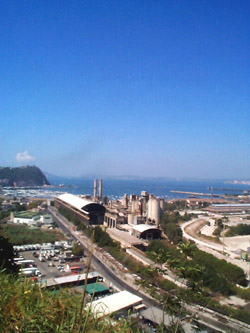 The
president of Italy was in Naples yesterday to attend the opening of
a new section of La Città della Scienza (The City of Science),
a large area—about 4 square miles—in Bagnoli, devoted to
the development of a combination hands-on science museum and exposition
grounds. The
president of Italy was in Naples yesterday to attend the opening of
a new section of La Città della Scienza (The City of Science),
a large area—about 4 square miles—in Bagnoli, devoted to
the development of a combination hands-on science museum and exposition
grounds.
The Gulf
of Naples really has two bays. In the east, the Bay of Naples, itself,
includes—at the extreme end—Sorrento; then, the towns along
the slopes of Vesuvius, the city of Naples, proper, and the areas known
as Mergellina and Posillipo. Rounding Cape Posillipo, you come to the
other bay: the Bay of Pozzuoli. It is very historic and includes the
small isle of Nisida, the town of Bagnoli,
the fabled Flegrean Fields , Pozzuoli
(with Lake Averno, the entrance to Hell in The Divine Comedy) and Baia,
the site of the Roman imperial port. The bay—and the Gulf of
Naples—ends at Cape Miseno, directly across from the islands of
Nisida and Ischia.
At the
beginning of the 1900s, the eastern end of the Bay Pozzuoli—precisely,
the town of Bagnoli and the area running out to Nisida—went through
years of extended industrial development. A steel mill was built there
as part of the mammoth development of the whole Neapolitan area, a project
lasting decades and known as the Risanamento
of Naples. The alternative plan—the one that was not chosen—involved
a quite different approach, architect Lamont
Young’s plan that would have turned Bagnoli into a pseudo-Victorian
imitation of a British seaside resort.
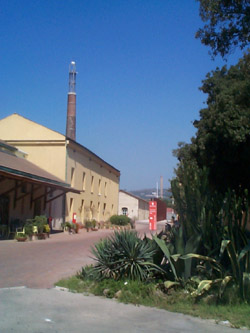 As
a result of the extreme industrialization of Bagnoli, the area simply
turned into an overbuilt blight of grime, noise, traffic and all those
things that one would rather not associate with what is, by common observation,
one of the most scenic bays in the Mediterranean. Things changed in
the 1990s: they closed the steel mill and started a gradual conversion
to a post-industrial local economy more based on tourism. The City of
Science has been open since November 2001 and is the cornerstone, so
to speak, of the whole plan. It fronts the sea with a beach and small
port for recreational craft. Eventually, the rejuvenation of the area
should "ripple" along the seaside past Bagnoli and Pozzuoli to Baia
at the other end. It is an ambitious plan, and one hopes for the best. As
a result of the extreme industrialization of Bagnoli, the area simply
turned into an overbuilt blight of grime, noise, traffic and all those
things that one would rather not associate with what is, by common observation,
one of the most scenic bays in the Mediterranean. Things changed in
the 1990s: they closed the steel mill and started a gradual conversion
to a post-industrial local economy more based on tourism. The City of
Science has been open since November 2001 and is the cornerstone, so
to speak, of the whole plan. It fronts the sea with a beach and small
port for recreational craft. Eventually, the rejuvenation of the area
should "ripple" along the seaside past Bagnoli and Pozzuoli to Baia
at the other end. It is an ambitious plan, and one hopes for the best.
Architecture (1), Spanish in Naples
| But
if there is an eighth wonder in the world, it must be the dwelling
houses of Naples…You go up nine flights of stairs before
you get to the “first floor. —Mark Twain, The Innocents
Abroad |
Indeed,
as one strolls almost anywhere in Naples—through the old historic
center of town or out along the road known as the Riviera di Chiaia—the
large buildings are still obvious, even in an age when skyscraper technology
seems to drawf all that has gone before. In most cases, the old apartment
houses in the center of town—say, on via dei Tribunali or via
San Biagio dei Librai—have a looming, monolithic look to them.
They were originally single–family dwellings. By “single,”
of course, I mean a single, noble, large family with dozens of servants
and a need for lots of room for extravagant parties and somewhere to
keep the horses and coaches. I’m sure the gigantic Palazzo of
the Emperor of Constantinople did the trick in the 1300s. It takes up
an entire block in the heart of the old center; it is an Angevin structure
from the 1300s. Today—at ground level—there is a long row
of small shops and stalls, and the upper floors house dozens of families.
The later
Spanish buildings are functionally very similar: an entrance large enough
for coaches to pass through, an internal courtyard, and around the courtyard
a four or five–story array of balconies, corridors and rooms.
In many cases in the downtown area, the courtyards now contain shops;
the upper floors have long since been subdivided into separate family
units. The trick is to keep the old façades and walls—then
pop in a spanking new modular kitchen or bathroom. (I have a friend
who lives in a perfectly modern apartment in Palazzo Casacalenda at
Piazza San Domenico Maggiore. What looks like a closet door in his living
room actually opens onto an internal stone spiral staircase from the
1600s leading to the roof of the building.)
When the
Spanish broke out of the confines of the original city walls and moved west out to what is
now the Riviera di Chiaia, they put up an impressive
string of villas along what was then the seafront. (The more recent
park, built by the Bourbons and now known as la
Villa Comunale (The Public Gardens) now lies between the original
villas and the water.) Most of those villa now have similar histories
of being turned to uses other than housing dukes and princes.
Palazzo
Carafa di Roccella is an interesting example. It sits two blocks back
from the Riviera di Chiaia on one of the main shopping streets in that
part of town. It is an enormous red building, a block long and four
or five stories high, and it has been abandoned and had scaffolding
on the façade for as long as I can remember—sort of a permanent
suggestion that they might be getting ready to do something with it
some day. It has been through various incarnations since it was built
in the 1600s, including a period in the early 20th century of total
abandonment and one in the 1960s when it almost fell prey to the land
developers’ wrecking ball (in which case, that part of town would
now have even more of those unsightly cement cracker boxes they built
to house the “economic miracle” of 40 years ago in Naples.)
Now, however—apparently, while I wasn’t looking—the
construction cranes have almost finished their job, the paint is almost
dry, “some day” is here, and the plan is for this old, old
building to house a new museum of modern art.
[ See
here for a separate entry on the "Spanish Quarter" of Naples.]
Art,
modern (2)
An exorcism,
of sorts, will take place at Piazza Plebiscito today when local poet
Salvatore di Natale will parade around near the bronze skulls installed
in the pavement (see here) and mutter
incantations to rid the city of the Evil Eye caused by the presence
of said crania. The poet’s name translates as Savior of Christmas,
which seems potent enough to me, but for this occasion he has redubbed
himself Mussasà Abdel Natal.
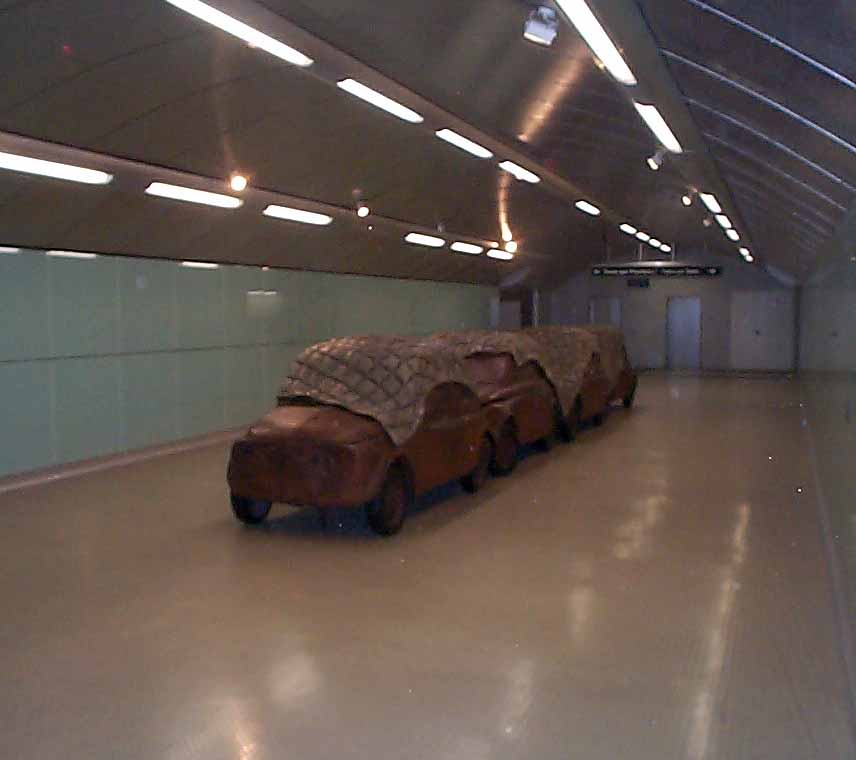 I, myself, have seen (photo, left)
the three old Fiat 500s parked, painted and installed as art in the
new subway station on via S. Rosa, so I sympathize with this letter-to-the-editor
in il Mattino. The gentleman says that he had finally evolved
a satisfactory intellectual interpretation of the artistic display of
old shoes in one of the new stations when he noticed the other morning
that someone had added a beat-up old hat and jacket to the exhibit.
Is this, he asks, an addition by the artist, perhaps something we might
call “Process Art”? Or is it crass and sarcastic vandalism?
Or—one more possibility—is it perhaps a simple act of charity
by some artistically illiterate, but good-hearted, person who has mistaken
the exhibit for a collection point for the needy? I, myself, have seen (photo, left)
the three old Fiat 500s parked, painted and installed as art in the
new subway station on via S. Rosa, so I sympathize with this letter-to-the-editor
in il Mattino. The gentleman says that he had finally evolved
a satisfactory intellectual interpretation of the artistic display of
old shoes in one of the new stations when he noticed the other morning
that someone had added a beat-up old hat and jacket to the exhibit.
Is this, he asks, an addition by the artist, perhaps something we might
call “Process Art”? Or is it crass and sarcastic vandalism?
Or—one more possibility—is it perhaps a simple act of charity
by some artistically illiterate, but good-hearted, person who has mistaken
the exhibit for a collection point for the needy?
Scugnizzo
(1)
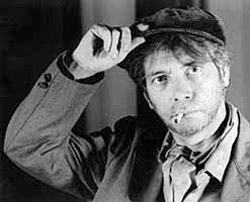 The
Neapolitan word scugnizzo is normally rendered in English as
“street urchin,” although that term—and others such
as “ragamuffin”—is too archaically cute to be much
help in understanding how these children of the street have typically
lived—and still live—in Naples. They are always poor, go
to school when they have to, and hustle through the rest of their young
lives by hook or crook; that is, with small jobs such as running errands,
washing windshields at stoplights, and, inevitably in some cases, by
descent into the seamy underworld of petty-crime. They scrape by. Indeed,
scugnizzo apparently comes from medieval vernacular Latin, “cugnare,”
meaning “to scrape”. The
Neapolitan word scugnizzo is normally rendered in English as
“street urchin,” although that term—and others such
as “ragamuffin”—is too archaically cute to be much
help in understanding how these children of the street have typically
lived—and still live—in Naples. They are always poor, go
to school when they have to, and hustle through the rest of their young
lives by hook or crook; that is, with small jobs such as running errands,
washing windshields at stoplights, and, inevitably in some cases, by
descent into the seamy underworld of petty-crime. They scrape by. Indeed,
scugnizzo apparently comes from medieval vernacular Latin, “cugnare,”
meaning “to scrape”.
Neapolitan
lore and literature is full of scugnizzi (the plural). Any collection
of late 19th–century photography of Naples has the obligatory
shot or two of the bare–foot kid hitching a free ride on the back
of the horse–drawn trolley or thumbing his nose at the well–to–do.
There is also a well–known 1931 play, “The Last Scugnizzo”
by Raffaele Viviani (photo shows Nino D'Angelo starring in a recent
version of that play) and the 1946 Oscar–winning bit of Italian
neo–Realism entitled “Sciuscià” directed
by Vittorio De Sica. That title, itself, was a neologism in Neapolitan
dialect from the local pronunciation of “shoe shine,” as
in the post-war phrase, “Hey, Joe, you want sciuscià?”
Also, the Neapolitan maker of films of social involvement, Nanny Loy,
turned out his Scugnizzi in 1989; that film is the basis for
the musical of the same name by Mattone and Vaime currently playing
to enthusiastic audiences in Naples. It has a mostly amateur cast of
young street–wise Neapolitans who know what they are singing and
dancing about. The piece is set against the backdrop of the jail for
juvenile offenders—still in operation—on the small isle
of Nisida off the shores of Bagnoli in
the Gulf of Naples.
The irony
is that while the president of Italy, Carlo Azelio Ciampi, was in Naples
the other day enjoying a production of the musical, a 13–year–old
boy, characterized in at least some newspaper accounts as a scugnizzo
was shot to death while trying to steal a motor-scooter. He and his
17–year–old accomplice pulled up on their own scooter alongside
a young man driving alone on his. “Give us your bike!” one
of them shouted. The potential victim, it turns out, was an off–duty
policeman in street garb, and he was armed. By his account, the two
both wore hoods. He turned to make a run for it, and they followed him.
This time, the one on the back of the scooter pointed a pistol at him
and the driver yelled, “Shoot! Shoot!” At that point, the
young cop pulled out his own pistol and—again, by his account—fired
one “downward warning shot” in their direction. Whatever
the case, the bullet struck the 13–year–old driver in the
face and passed through to wound the accomplice on the rear seat. The
young driver died shortly thereafter, and his accomplice was taken to
a hospital. He will recover. The pistol he had pointed at the cop was
found at the scene. It was a plastic toy.
The mother
of the child is screaming (through lawyers) that her son was murdered
by a trigger-happy cop. The policeman—only 20–years–old,
himself—claims he was afraid for his life and fired only to warn
his assailants. Investigations are now going on into whether he may
be charged with, as the law puts it, “culpable use of excessive
force in self-defence”. I have no idea how that will turn out,
nor do I know anything about the boy that died. I do think, however,
that musicals about poverty lend an air of illusory delight to a condition
that will not be sung and danced away.
Presepe (2), Christmas (6), San Gregorio Armeno (3)
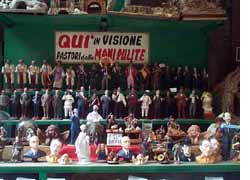
The holiday
season was officially over a couple of days ago with the coming of la
befana. The shops on the main thoroughfare for buying one's holiday
decorations, via San Gregorio Armeno, are closing down, although some
of them stay open most of the year to handle general tourist trade.
One such
shop displays the most unlikely cast of characters ever intended for
a "presepe" (nativity scene) in Naples. It is a display of figures
dubbed, collectively, "The Shepherds of the Clean Hands" --"clean hands"
(photo) being the name of the great anti-crime campaign started in Italy
in the early 1990s. Depending on mood of the shopkeeper, figures can
be identified as anyone from the mayor of Naples to the Prime Minister
of Italy to the various magistrates involved in the struggle—or
just generally famous and infamous characters. This year, Osama Bin
Laden was twice present—once sitting on an elephant! He is directly
next to a more traditional rendering—that of a beheading—originally
meant to be the execution of John the Baptist. The sign, however, tells
us that this is the head of "Bossi," an extremely unpopular (in southern
Italy) politician from the north. Busts at the very front of the display
this year included Mussolini, the playwright Eduardo de Filippo, and the great Neapolitan comic,
Totò.
There is
no particular ideological ax being ground in any of this. It is in keeping
with the whole hodge-podge nature of the entire street, where, in the
midst of items such as the Star of Bethlehem and The Three Wise Men,
which might focus your devotion to the spirit of the season (once you
get them home), there are also boxes of white plastic skulls (from the
Fontanella tradition— see
here for a relevant entry), horrible recordings of “Here Comes
Santa Claus” and paper mache mannequins of Laurel and Hardy.
Architecture
(2)
The
worst place to put a building like this.
|
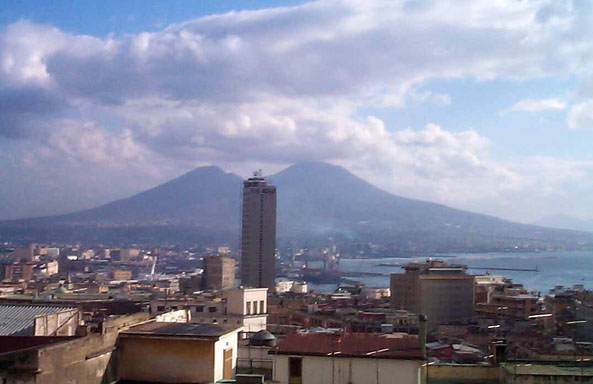
Like most
people who know nothing of what they spout off about, I know what I
like, and of all the chunks of so-called architecture I don't like in
Naples, the Jolly Hotel downtown (photo, above) is at the top
of my list. This grotesque people-box looks as if some brain-dead band
of miscreants first built a tawdry one–story hick motel and then
decided to pancake fifteen of them straight up. They even put a neon
sign on top. “Jolly,” it says. Only Italians know that the
“Jolly” is the Joker in a deck of cards. Visitors from elsewhere
no doubt think that this the place to come to get your jollies. If I
had real power, I would contact the aliens who wasted so much valuable
time mutilating cattle in the Rockies and kidnapping FBI agents for
The X-Files and get them to abduct the architects of this monstrosity
and hurt them real good, and then zap that baby straight into the center
of the sun.
While they're
at it, the aliens can take the bottom station of the Chiaia cable–car
at Piazza Amedeo. That used to be a quaint turn–of–the–century
cable–car station, a sweet little number that cradled you while
you waited and let you forget about traffic jams and such. Then, they
tore it down and put up a concrete and steel–girder station. At
least they tried to put one up, because when the people in the adjacent
apartment house saw the Quonset Hut from Hell inching up next door,
they sued the city to stop construction. They won their case, but in
its infinite delay the law didn't stop the building until the steel
beams were inches from the windows in the apartment building. For well
over year, tenants couldn’t leave their windows open without feeling
that this skeleton with a corrugated tin hat was leering in at them.
(The law was finally translated into action. The steel girders are gone
and residents can now glance out and have an unobstructed view of what
is left of the station.) If the station had been finished as designed,
it was surely destined to wind up like its sibling, the cable–car
station of the Montesanto line in the Vomero section of town. This thing
looks like what you get when you sneak up on the Führerbunker
and spray it with shaving cream. The aliens can have that one, too.
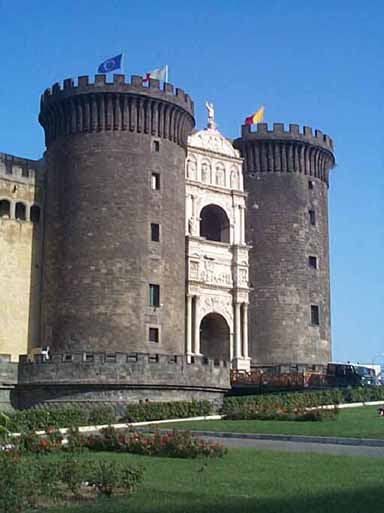 On the other hand, I like the castle at the port of Naples (photo, left). It's good
solid fourteenth–century monolithic fortress architecture. It
has what every twelve–year–old boy could ask for in a building:
crenels, merlons, battlements, arrow loopholes, bastions, casemates,
turrets, and a moat. A moat, for Pete's sake! One that used to have
crocodiles in it! (I realize that story is not true, but I enjoy repeating
it.) Sadly, cars now park where crocodiles used to prowl, but that is
not the fault of the fortress. I also like the Galleria Umberto across from the San
Carlo opera house. It's an 1890 hybrid of a shopping mall and a
cathedral, a glass and girder dome sheltering four vast naves below.
Its construction was a boon to that part of town and it is still a kind
of sitting–room for the city; you wander in, have a coffee, check
out the shops, and if you go on Saturday or Sunday mornings, maybe even
wind up as an extra in a film, since the Galleria is the place where
local directors rightfully figure they can find at least a few suitably
strange characters such as yourselves. On the other hand, I like the castle at the port of Naples (photo, left). It's good
solid fourteenth–century monolithic fortress architecture. It
has what every twelve–year–old boy could ask for in a building:
crenels, merlons, battlements, arrow loopholes, bastions, casemates,
turrets, and a moat. A moat, for Pete's sake! One that used to have
crocodiles in it! (I realize that story is not true, but I enjoy repeating
it.) Sadly, cars now park where crocodiles used to prowl, but that is
not the fault of the fortress. I also like the Galleria Umberto across from the San
Carlo opera house. It's an 1890 hybrid of a shopping mall and a
cathedral, a glass and girder dome sheltering four vast naves below.
Its construction was a boon to that part of town and it is still a kind
of sitting–room for the city; you wander in, have a coffee, check
out the shops, and if you go on Saturday or Sunday mornings, maybe even
wind up as an extra in a film, since the Galleria is the place where
local directors rightfully figure they can find at least a few suitably
strange characters such as yourselves.
Now that
I am being opinionated and Philistine about architecture, here is some
more—and I know the hard time I am going to get on this. I like
the architecture of Fascism in Naples. Now, it is no secret that from
the Great Pyramid of Cheops to Louis XIV's Palace at Versailles, big
governments build big. Nor does it take any profound symbol–crunching
to understand architecture as extension of the tyrant's ego. Yet, in
our own century, this kind of fervor has produced such ugliness that
the results would be funny if they didn't remind us of the grim realities
that accompanied them. I'm thinking primarily of the architectural corn
that Hitler planted in Germany in the 1930s, replete with over–sized
statues of Siegfried. Almost as bad were the grim mastodons of Socialist
Realism in the Soviet Union—a succession of joyless, clumsy and
intimidating buildings put there, no doubt, to remind you to shut up.
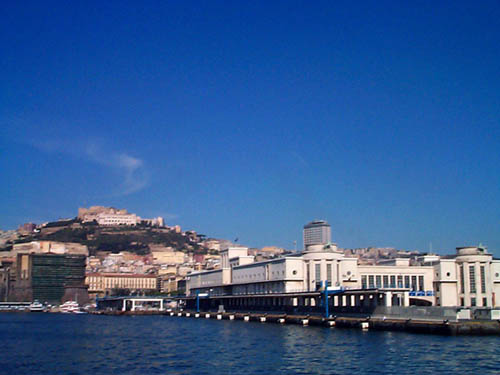 The Italian examples of
totalitarian architecture—at least the ones I have seen in Naples—don't
strike me that way at all. Yes, they are big, but they are big and shining
and optimistic. The great white passenger terminal at the port of Naples
(photo, left) , finished in 1939, looks, itself, like some magnificent
vessel about to set sail. The main post–office at Piazza Matteotti
is the best example, however. It could be a set from the science–fiction
film of the 1930s, Things to Come. (The post-office was, in fact,
completed in 1936, also known—as the friendly inscription on the
side reminds us—as "Year XIV of the Fascist Era". That inscription
was recently restored such that it is completely and un–selfconsciously
legible.) The great smooth black and white marble façade is lined
with row after row of rectangular windows, so symmetrical and unmoving
that the building itself looks entranced. At first glance, it might
all be one giant tribute to the static perfection of the right-angle—in
short, a big box. Yet, that is deceptive, for the smooth façade
curves into the entrance, producing two pseudo–columns almost
as tall as the building, itself, and the entire considerable length
of the building is actually a gigantic curve. Thus, instead of flatness,
we have some three–dimensional geometry of straight lines and
curves. Surely, this is what a space station should look like. The Italian examples of
totalitarian architecture—at least the ones I have seen in Naples—don't
strike me that way at all. Yes, they are big, but they are big and shining
and optimistic. The great white passenger terminal at the port of Naples
(photo, left) , finished in 1939, looks, itself, like some magnificent
vessel about to set sail. The main post–office at Piazza Matteotti
is the best example, however. It could be a set from the science–fiction
film of the 1930s, Things to Come. (The post-office was, in fact,
completed in 1936, also known—as the friendly inscription on the
side reminds us—as "Year XIV of the Fascist Era". That inscription
was recently restored such that it is completely and un–selfconsciously
legible.) The great smooth black and white marble façade is lined
with row after row of rectangular windows, so symmetrical and unmoving
that the building itself looks entranced. At first glance, it might
all be one giant tribute to the static perfection of the right-angle—in
short, a big box. Yet, that is deceptive, for the smooth façade
curves into the entrance, producing two pseudo–columns almost
as tall as the building, itself, and the entire considerable length
of the building is actually a gigantic curve. Thus, instead of flatness,
we have some three–dimensional geometry of straight lines and
curves. Surely, this is what a space station should look like.
The post–office
is, indeed, art–deco, that "futuristic" style from the 1930s,
the clean, simple forms of which kept cropping up at exhibitions and
World's Fairs of that decade, telling us what the world would look like
fifty years down the road. One 1930–ish prediction missing from
the main post–office, I suppose, is a transparent people–moving
tube, high above ground, leading away from the building, perhaps in
the direction of the spaceport or the planetary weather control station.
And in place of the personal electric helicopters zipping about in front,
there is a real live 2003–ish traffic jam. But just as with the
fortress down at the harbor, that's not the fault of the building.
Frederick
II
The
Empire Strikes Back
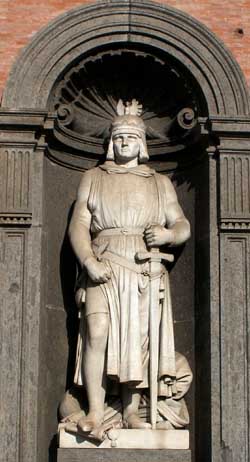 A
statue of Frederick II is the second in a row of eight along the façade
of the Royal Palace in Naples; they show the dynasties which ruled The
Kingdom of Sicily (later known as the Kingdom of Two Sicilies or, simply,
the Kingdom of Naples) from the Normans
in the 11th century to the unification of Italy eight-hundred years
later. They are all the same size, but if they were hewn to scale in
terms of historical importance, none would be larger than Frederick.
It would be very hard to fit this last great medieval emperor, this
scholar, diplomat and warrior into that tiny niche. A
statue of Frederick II is the second in a row of eight along the façade
of the Royal Palace in Naples; they show the dynasties which ruled The
Kingdom of Sicily (later known as the Kingdom of Two Sicilies or, simply,
the Kingdom of Naples) from the Normans
in the 11th century to the unification of Italy eight-hundred years
later. They are all the same size, but if they were hewn to scale in
terms of historical importance, none would be larger than Frederick.
It would be very hard to fit this last great medieval emperor, this
scholar, diplomat and warrior into that tiny niche.
Knighthood
and chivalry; popes and princes; kings, castles and Crusades; valor
and skullduggery—all these things tumble together in our
hazy modern perception of what the Middle Ages were all about. The Middle
Ages are, indeed, confusing, but Frederick II provides an excellent
focal point if we wish to understand not only the Middle Ages, but the
essential point that some of the great issues which caused conflict
then—religion, power, monolithic states versus cultural
diversity—have not yet been resolved.
Centuries
of struggle between the Church and the State in Europe came to a head
in the 1200s. On the one hand, politically, Europe had been reformed
by Charlemagne a few centuries after the fall of the Roman Empire with
the view that The Empire, a vast monolithic state, should continue.
In spite of Charlemagne's failure to forge a lasting empire, that idea
took hold. It was, in hindsight, a rather futile endeavor in light of
the emergence of separate 'national' identities in Europe—the
French, the Germans, the Spanish and the Italians; yet, the idea remained
that they could be joined through the single overarching person of the
emperor. A strong contender among European royal houses of that age
to provide just such a strong emperor was the German house of Hohenstaufen,
the house of Frederick II.
On the
other hand was the Church of Rome. It had come into its own,
on the worldly plane, in 756, when Charlemagne's father, Pepin III,
rendered unto Christ a lot of what had belonged to Caesar: land. That
gift—a large part of central Italy—was the
beginning of the Papal States, a church-state ruled by the Pope King.
Over the next few centuries, a papal vision took form, a vision of Europe
as a single theocracy with earthly princes subject to the princes of
the Church, or, in the words of Pope Gregory VII, pope from 1073 to
1085: "The Holy See has absolute power over all spiritual things:
why should it not also rule temporal affairs? God reigns in the heavens;
His vicar should reign over all the earth." Clearly these two points
of view on how Europe should be ruled were destined not to get along
very well. And, indeed, they did not.
Frederick
II of Hohenstaufen was born near Ancona in the Papal States in 1194.
He was the grandchild of emperor Frederick I and beneficiary of the
marriage of his own royal family into that of the Norman rulers of the
Kingdom of Sicily (a kingdom, remember, that included the southern Italian
mainland). Frederick was crowned King of Sicily as a young child, and
he spent much of his childhood in the south. His mother appointed Pope
Innocent III guardian of the child, a fact that may have fooled the
Pope into thinking that here, some day, at last would be an emperor
the Church might get along with.
Frederick
was crowned Holy Roman emperor at age 26 and set about continuing the
Church/State struggle that his grandfather had waged years earlier.
His task was to unite the north of Europe, the lands of the German princes,
with the south, the Kingdom of Sicily. Standing in the way was the Church,
the Papal States, aided by some central and northern Italian city-states
that had become independent of imperial authority and liked it that
way. These, in essence, were the battle lines: the so-called "Ghibellines"
(from the German place name "Waiblingen"), in favor of a strong emperor
vs. the "Guelphs" (from "Welf," the name of a Saxon royal family, who
supported Papal authority.
Frederick
had his own son installed as King of the lands of Germany, setting the
stage for eventual unification of north and south. He then set about
solidifying his own rule in the Kingdom of Sicily. He built a chain
of castles and border fortifications, built a naval as well as a merchant
fleet, and created a civil service for which candidates were trained
at the very first European state university, which he founded in Naples
in 1224.
Bound by
oath to undertake a Crusade, Frederick finally did so, and, amazingly,
through a series of complex negotiations—as opposed to
the usual bloodshed—obtained Jerusalem, Bethlehem and Nazareth
from the sultan al-Kamil of Egypt. Considering the bloody Crusades of
the previous century and the enmity between Christianity and Islam of
that period, the fact the Frederick II of Hohenstaufen wound up—peacefully!—being
crowned king of Jerusalem in the Holy Sepulcher in 1229 must rank high
in the annals of diplomacy. Remembering his background, perhaps it is
not surprising. Frederick had been raised in Sicily within living memory
of Norman rule, that last great period of tolerance in European history,
a time that saw Greeks, Italians and Arabs all forge their respective
cultures—including religions—into a single
state that worked. Frederick, himself, was fluent in Greek, French,
Latin, vernacular Latin (which became Italian) and Arabic. (In his spare
time, Frederick also wrote a treatise on falconry, considered one of
the first European examples of natural history, based, as it was, on
Frederick's own observations of the creatures in the wild.)
The emperor's
behavior in Jerusalem gave the Pope something to ponder, for Frederick
had issued a proclamation comparing himself to Christ, recalling his
earlier remarks, supposedly in jest, that Moses, Christ and Mohammed
had been impostors! (There is actually an extant document entitled Three
Great Imposters; there are, to be sure, other possibilities as to
the author of that document, but Frederick is a plausible choice.) Papal
troops invaded Sicily shortly thereafter; after all, it surely could
not have been very comforting to a Pope to realize that there was now
a powerful emperor with a Messianic complex on the loose. Frederick
nevertheless managed to return to Italy, defend his kingdom, and smooth
things over with the Papacy.
In 1231
Frederick came up with a new constitution for the Kingdom of Sicily.
It was the first time since the rule of the Byzantine emperor Justinian
in the 6th century that the administrative laws of a European state
had been codified. The constitution was revolutionary, anticipating
the central authority and enlightened absolutism of a later age.
Frederick's
troubles in the north were growing, however. He was unable to thwart
the resistance by northern Italian city-states and the princes of Germany
to imperial rule. Also, Pope Gregory IX, fearful of eventual encirclement
by an earthly empire, excommunicated Frederick in 1239. Frederick countered
by invading the Papal States in 1240, threatening to take Rome, itself.
He did not carry out his threat, however; he settled for taking 100
clerics prisoner, thereby reinforcing his reputation not only as an
oppressor of the Church, but perhaps as the Anti-Christ, himself.
In 1245
the Pope declared the Emperor to be deposed. The effectiveness of such
a declaration clearly depends on (1) ability to enforce, and (2) willingness
to comply, neither of which elements were in great abundance. At the
time of his death in 1250 Frederick was still in a strong position,
but within 25 years, his heirs had fallen victim to the same struggle
with the Papacy that had taken up his own life. The last Hohenstaufen
pretender, Conradin, was executed in Naples by the Angevin rulers who
had replaced Frederick.
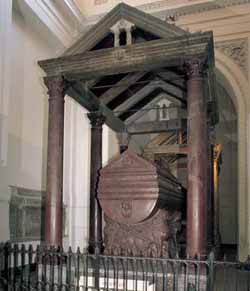 Frederick
was entombed in the cathedral of Palermo (photo, left), surrounded by
symbols of Roman Catholic, Greek Orthodox and Arab respect, eulogies
to an emperor as well as appropriate tributes to the peculiarly southern
fusion of cultures that had shaped him. Almost immediately the belief
took hold that he would return some day to restore the Empire. Even
Frederick II was not that much larger than life, but the Messianic overtones
of such an idea help us understand just what it meant to command true
awe in the Middle Ages. Frederick
was entombed in the cathedral of Palermo (photo, left), surrounded by
symbols of Roman Catholic, Greek Orthodox and Arab respect, eulogies
to an emperor as well as appropriate tributes to the peculiarly southern
fusion of cultures that had shaped him. Almost immediately the belief
took hold that he would return some day to restore the Empire. Even
Frederick II was not that much larger than life, but the Messianic overtones
of such an idea help us understand just what it meant to command true
awe in the Middle Ages.
So, who
won the battle? Not Frederick, clearly. But not the Church, either.
By encouraging anti-Imperial sentiment, the Church unwittingly helped
foster the new European consciousness of "nationality". Within half
a century of Frederick's death, France was so strong that the French
king had the Pope taken hostage, and eventually forced the removal of
the Papacy from Rome to Avignon. When the Papacy returned to Rome almost
a century later, Italy and the times would be fertile soil for the new
ideas of the Renaissance, an unprecedented wave of creativity that the
Church itself would promote—and which had been foreshadowed
by Frederick's wide-ranging abilities.
Anthropolgy,
Neapolitan culture (1),
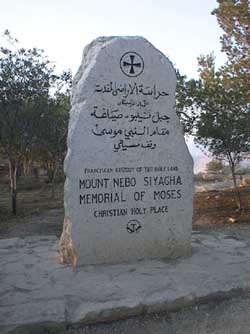 I’m
reading a fascinating book entitled The View from Nebo. How Archaeology
is rewriting the Bible and reshaping the Middle East, by Amy Dockser
Marcus (Little, Brown and Company. 2000. Boston.) Strangely enough,
I am reminded of Naples. The section that draws my attention is a chapter
on the relationship of modern Jordan to the ancient Ammonites, a people
contemporary of the Israelites at the time of the destruction of Jerusalem
by the Babylonians in the sixth century b.c. The salient point for the
author is that modern Jordanians, for various reasons, fail to realize
how connected they are historically to a people—the Ammonites—who
were true “survivors,” true builders of what archaeologist
Oystein LaBianca has termed “indigenous survivor structures”. I’m
reading a fascinating book entitled The View from Nebo. How Archaeology
is rewriting the Bible and reshaping the Middle East, by Amy Dockser
Marcus (Little, Brown and Company. 2000. Boston.) Strangely enough,
I am reminded of Naples. The section that draws my attention is a chapter
on the relationship of modern Jordan to the ancient Ammonites, a people
contemporary of the Israelites at the time of the destruction of Jerusalem
by the Babylonians in the sixth century b.c. The salient point for the
author is that modern Jordanians, for various reasons, fail to realize
how connected they are historically to a people—the Ammonites—who
were true “survivors,” true builders of what archaeologist
Oystein LaBianca has termed “indigenous survivor structures”.
Far from
disappearing from history, the Ammonites used such “survivor structures”
as developing a strong sense of family and tribalism, decentralizing
the administration of food and water supplies, keeping a very low profile
in the face of overwhelming force (so low, in fact, that they apparently
had a network of “cave villages” beneath the very ground
that Nebuchadnezzar’s armies were occupying. Interestingly, also,
is that one of the “strategies” was the development of a
“culture of hospitality that created a network of sharing favors
and information…” The key phrase in the chapter is:
| …the
Ammonites had survived for so long because they had been open to
outside cultural influences and trade with their neighbors, always
finding a way to adapt these things to their own circumstances. |
Much of
that applies to Naples; it is quite clearly a “survivor culture”.
I think that is a positive term. “Resilient” and “adaptive”
would be others. “Sponge culture”—which I have heard—has
negative overtones I don’t like, implying a parasite culture,
one that takes but never gives. I have heard “chameleon culture,”
as well. I don’t like that one, either, perhaps because of the
implication of deceit and lack of originality. None of that is true
of Naples. What is true is that Naples is the oldest continuously inhabited
center of large population in Europe. You can trace the steps these
people have taken from the Greeks to the Romans; then through the independent
duchies to the Normans, French, Spanish and on into modern-day Italy.
At each step of the way, they have reinvented themselves through strategies
very similar to those mentioned above: adapting outside influences to
their own circumstances; bending but not breaking in the face of power;
reliance on friends and family; and hospitality.
This makes
me wonder if there is less of a clash—or, at least, if there are
more flexible boundaries—between “insider and “outsider”
in Naples. We all know that there are things that “mark”
us as outsiders in another culture. Language is certainly one of them.
Again in the Bible, the Gileadites distinguished their own soldiers
from the Ephraimites on the basis of the pronunciation of the word “shibboleth”.
Those who could not pronounce the “sh” correctly were the
enemy and paid the price. If you don’t speak the language—one
huge shibboleth—you will not fit in. It comes as a surprise to
many, however, that even when they do speak the language, and even if
they “say” all the other general cultural shibboleths properly,
they still don’t fit in. They can never “unmark” themselves.
Naples is not one of those cultures. Perhaps it has cultural markers
that are less rigid—or, at least, more forgiving. It’s almost
as if Neapolitans change their own pronunciation of “shibboleth”
to fit yours. Thus, any perception that I may have of not “fitting
in” may be just that—my own perception, the result of the
quirk-ridden cultural and personal baggage that I carry around with
me. (Admittedly, I am embarrassed to walk into my morning coffee-bar
and ask, “Say, fellows, do I fit in?”)
It certainly
seems less incongruous to me now than once upon a time to walk out of
a 17th-century Spanish monastery and a concert of Neapolitan Baroque
music and directly into the MacDonald’s across the street where
American jazz or home–grown Neapolitan rap music is coming through
the in–house speakers. There are two possibilities: none of it
fits, or it all fits. Maybe I do, too—more than I think.
Language/s
(2), "baloney"
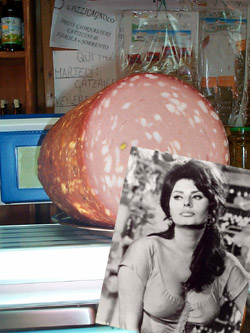 (Sorry.
You'll have to read the entry to find out what this photo is all about.) (Sorry.
You'll have to read the entry to find out what this photo is all about.)
From the
Department of Fanciful but Pretty Good Etymology. I see that even the
OED (Oxford English Dictionary) is hazy about the word “baloney,”
in the sense of “humbug” or ”rubbish”:
Commonly
regarded as from Bologna (sausage) but the connection remains conjectural.
I had a
Neapolitan—or, at least, southern Italian—explanation all
worked out, and it wasn’t bad. It wasn’t true, but it wasn’t
bad. It is well-known (according to a local TV station, and why would
they lie?) that immigrants to the US from these parts would commonly
smuggle forbidden sausage past customs inspectors by hollowing out large
blocks of cheese and stashing the meat in there. Thus, assuming that
“baloney” is a cute diminutive from “Bologna”
(probably) and if a certain kind of Bologna sausage is a smuggled item,
then “baloney” becomes a synonym for “that which is
false”. Unfortunately, that well-constructed syllogism is almost
certainly low-grade bockwurst, if not downright baloney, since southern
Italian immigrants were smuggling a totally different kind of meat,
and I don’t think you could take in cheese, either.
A better
explanation is that in the city of Bologna, there used to be a medieval
market that traded in phoney gold, such that there is a common doggerel
proverb in Italian that says:
“L’oro
di Bologna/si fa nero per la vergogna”
“Gold from Bologna turns black from shame.”
There is
even a common Italian verb, sbolognare—which contains the
name of the city—meaning “to get rid of something,”
with the implication that the object is, if not worthless, at least
not useful. That expression is probably connected with the trade in
fool’s gold. Though there is no Italian expression that uses the
name “Bologna,” itself, as a synonym for “worthless,”
that meaning might have developed as an Italian-Americanism within the
immigrant community.
The sausage
in question is mortadella, a concoction of pork, donkey and wild
boar—a mystery meat minced by medieval monks. The mortadella
from Bologna was so highly prized that even today in Italy the name
of the city is a synonym for the meat. You walk in and buy Bologna.
Thus—let’s see how this is doing, so far—Bologna,
fool’s gold, mortadella, immigrants—ergo, mortadella
(baloney) is a metaphor for that which is not authentic. Also—if
you have seen the 1971 film with Sophia Loren, La Mortadella—she
tries to walk past the customs station in New York with one very large
piece of Bologna, only to be told that “you can’t bring
salami into the country”. (In the photo, above, Sophia is the
one in the lower right.)
“It’s
not salami. It’s mortadella,” she says.
The rest
of the film revolves around the almost theologically fine distinction
between minced pig, donkey, and boar, and minced whatever-else goes
into “real” sausage. Thus, there is that aspect, as well:
mortadella/Bologna/baloney as second-rate meat.
I hope
I get a nice letter from the OED. And I challenge them to say “mystery
meat minced by medieval monks” really fast. Five times.
Buffalo
Bill
For no
reason that I can determine, il Mattino, the largest Neapolitan
daily ran a photo the other day with a simple caption and no story.
The photo showed a well-tended grave site. The caption read:
| The
legend of Buffalo Bill is still alive. After more than a century
the myth holds on. Every year, millions of persons visit Colorado
and the tomb of Colonel William Cody and his wife. |
End of
story. The paper missed the chance to tell its readers about Buffalo
Bill’s visit to Naples in 1890.
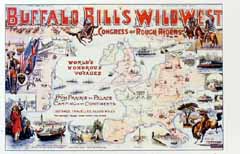 European fascination for the American
West was never more in evidence than in the late 1800s. Cody—after
a lifetime of hunting, scouting and soldiering— took his enormously
successful Wild West show on two tours of Europe. In 1887 he and his
troupe went to Britain where they played to enthusiastic crowds—indeed,
to an enthusiastic Queen Victoria, herself, who liked the show so much
that she went back to see it a second time. Everyone was eager to see
the fabled buffalo hunter and Indian fighter, the sharp–shooting
Annie Oakley and bands of real Sioux warriors and, maybe—as did
the Prince of Wales—even ride on the fabled Deadwood Stage! European fascination for the American
West was never more in evidence than in the late 1800s. Cody—after
a lifetime of hunting, scouting and soldiering— took his enormously
successful Wild West show on two tours of Europe. In 1887 he and his
troupe went to Britain where they played to enthusiastic crowds—indeed,
to an enthusiastic Queen Victoria, herself, who liked the show so much
that she went back to see it a second time. Everyone was eager to see
the fabled buffalo hunter and Indian fighter, the sharp–shooting
Annie Oakley and bands of real Sioux warriors and, maybe—as did
the Prince of Wales—even ride on the fabled Deadwood Stage!
Two years
later, they returned to Europe and went to Italy where they were invited
to the Vatican to attend the celebration of the tenth anniversary of
the coronation of Pope Leo XIII. Also, in Verona, Cody fulfilled his
ambition of exhibiting his "Wild West" (he disliked the term "show")
in an ancient Roman amphitheater. (In Rome he was unable to fulfil his
dream of playing in the Coliseum, itself, as there was too much rubble
and stone cluttering the arena; he settled for having himself and his
troupe photographed in front of it.)
A high
point of the visit to Rome was a bronco-busting challenge "grudge match"
between Buffalo Bill's cowboys and true working cowhands from the Maremma
region in central Italy, men who spent much of their time working with
the Cajetan breed of horse, the wildest and most unmanageable in Italy.
The Prince of Teano challenged Cody's men to break the Cajetans. Twenty
thousand spectators saw the contest. The Rome correspondent of the New
York Herald wrote:
| The
brutes made springs into the air, darted hither and thither in
all directions, and bent themselves into all sorts of shapes,
but all in vain. In five minutes the cowboys had caught the wild
horses with the lasso, saddled, subdued and bestrode them. Then
the cowboys rode them around the arena while the dense crowds
applauded with delight. |
Depending
on who is telling the story, the Maremma cowboys were then only marginally
to moderately successful at trying to duplicate that feat on Cody's
horses.
Buffalo
Bill opened in Naples on January 26, 1890. (An imaginative local had
counterfeited more than two-thousand tickets—and why am I not
surprised at that?!—producing great confusion at the opening.)
An ad in the Neapolitan newspaper, il Paese, that day announced:
Buffalo
Bill's Wild West!
100 Indians!
100 Marksmen!
Hunters & Cowboys!
200 animals, including wild buffalos!
2 Week Engagement—Daily, 2,30 p.m.
Corso Meridionale, at the Rione Vasta.
Tickets: 1, 2, 3, 5 lire. |
And so
Buffalo Bill let the West run wild in Naples for a while. Bear in mind
that no one—not Cody, not his company, and certainly not the people
who watched them perform throughout Europe—viewed this as a circus.
It was more of a replay, if you will, of current events. In 1890 the
Indian Wars that had raged along the American frontier had not even
totally subsided. The West may have been 'won,' but the combatants were
still very much alive. The Native Americans in Cody's troupe were not
stage 'Indians'—they were the real thing, many of the very same
Sioux braves who had fought Custer at the battle of the Little Big Horn.
Indeed, they were in Cody's troupe only because he got them released
into his custody for his tour after they were imprisoned in the wake
of the last great Sioux uprising. Back in America, Chief Sitting Bull
was still alive and still their leader, (although he would be "shot
while trying to escape" from internment later that same year of 1890).
(Cody would live until 1917.)
The Neapolitan
papers praised Cody and his band:
| That
which may seem to the everyday Neapolitan to be a kind of game,
an idle display of skill, is nothing less than a common necessity
of everyday life in a country where acrobatic agility, boundless
audacity and prowess are conditions for survival. |
The reporter
was enthusiastic, yet, in the next breath, melancholy at what apparently
was a "faithful reproduction" of the passing of a native race, of the
"…red race fleeing from destruction wrought by whites".
Today,
those raised on the "authenticity" of films and television can scarcely
comprehend what a live display of this kind must have meant to Europeans
of the late 19th century. Speaking of a simulated Sioux attack on an
immigrant wagon train, part of the daily show in Naples, the reporter
for il Paese continued:
| No
description can convey the effect of an authentic mounted charge
by Indians, this folk who here show us a few meagre scenes from
a life that until a few years ago was theirs to lead untrammelled. |
Buffalo
Bill Cody had brought a kind of time machine with him. He had opened
a window and given a privileged few a chance to look out and glimpse
something very rare: an authentic reproduction of a way of life played
for them by the very people who had led it. The window would soon close
and the players would become anachronisms and caricatures of themselves.
Then, generations of imitators and made–up distortions of "cowboys
and Indians" would follow. For a fleeting moment, however, the citizens
of Naples and other European cities got a chance to see the real thing.
Confederate
flag, Neapolitan culture (2)
If you
let your eyes wander along the display of flags mounted over the entrance
to one seaside restaurant in particular down at the small port of Mergellina,
you can test your vexillological prowess: Let’s see—that
one is Brazil; there’s France…hmmm, the Scandinavian ones
are confusing, and did you ever notice that Belgium is the same as Germany
except on its side, but not quite? Say, they even have the new European
flag up and waving. Wait, what’s that? A blue St. Andrew’s
cross with white trim, 13 stars arrayed within the bars of the cross,
all on a field of red…a Confederate flag.
Well, maybe
they just found one and put it up because it’s a nice design.
Not quite. It’s up there for the same reason that it is painted
on the entrance to a bar not far from the restaurant, a club with the
delightfully oblivious–to–American–idiom name of “Southern
Bull”. The bull, in this case, is to be understood not as in “What
a bunch of…,” but rather as in “raging,” one
fine, prime specimen of which species is superimposed, snorting and
swollen with pride, on the flag, itself—a raging bull from the
south (of Italy, of course). Similarly, if enough fans to constitute
a rooting section ever show up again at a Naples home game at the San
Paolo soccer stadium, you will see a number of such flags fluttering
in the breeze. These will have an interesting variation: the circular
logo of the Naples team is positioned at the center of the cross and
inscribed—in English!—around the perimeter of that logo
is the phrase, “The south shall rise again.”
You don’t
need a degree in cross-cultural anthropology to figure this one out.
As losers in their own war against their own north 140 years ago, Neapolitans
identify with the defeated south in the US Civil War. They watch “Gone
With the Wind,” and they know who the good guys are. Unlike some
places in the southern US today, there is no doubt in Naples as to whether
that flag stays up or comes down. It stays up—and they just ain’t
whistlin’ ‘o sole mio.
Castrati
"The
most unkindest cut of all." —Julius
Caesar, Act III, Scene 2.
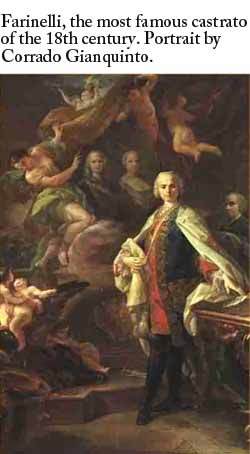 Well,
Will, we'll worry about your grammar later. First, let me tell you a
few things about unkind cuts, which, in your frenzied groping for superlatives,
you seem to have overlooked. What follows is not for the squeamish,
so gird your loins. Wait, belay my last. Forget your loins. By the time
I'm through, you'll never want to hear the word "loins", again. Well,
Will, we'll worry about your grammar later. First, let me tell you a
few things about unkind cuts, which, in your frenzied groping for superlatives,
you seem to have overlooked. What follows is not for the squeamish,
so gird your loins. Wait, belay my last. Forget your loins. By the time
I'm through, you'll never want to hear the word "loins", again.
In his
short reign (1585-90) as Pontiff, Pope Sixtus V (no kin to Fiftus VI)
strengthened the financial policies of the Roman Catholic Church, straightened
out its administration, finished St. Peter's Dome and more or less geared
up the Church for the Counter-Reformation. He is also known for his
no nonsense interpretation of 1 Corinthians, XIV, 34, in which Paul
tells us: "Let your women keep silence in church; it is not permitted
unto them to speak." The Pope, hard-liner and tone deaf, reckoned
that singing was just a funny kind of speaking, anyway, so let's not
let them sing, either. This led directly to the wholesale revival of
the ancient and hideous practice of castration.
Being a
choir master in those days was frustrating. The so-called "white voice"
of children was a natural in church; it was surely the same high, pure,
innocent voice as that of Heaven's own puffy-cheeked little cherubs
and angels. But it still had to be trained, and no sooner did you get
a young boy finely tuned and able to sing well, than Nature let him
have it with a jolt of testosterone, giving him pimples and otherwise
priming him for years of anxiety-filled social gaming, a dubious trade-off
every now and then for brief spurts of intense pleasure. More to the
case in point, it also sent his voice cracking and plummeting into the
octaves below and sent the choirmaster, in his own dogged imitation
of Sisyphus, wearily back for another kid, never ever winding up with
a well-trained strong adult soprano singer. Women, as we have noted,
were out of the question.
There were
two ways to get post-pubescent male sopranos. The first was to train
the "falsetto" voice, that bit of vocal chord contortionism which puts
out that high, breaking voice associated today mainly with certain kinds
of folk music, such as the Swiss yodel or American country music. "Falsetto",
in Italian, is a diminutive of "false", and that is just how the public
felt about it: a false little voice, a scrawny and brittle stand-in
for the real thing, completely unacceptable to music-lovers.
Enter a
solution which made the purists happy, putting them, uh, on the cutting
edge of Baroque vocal technology. It was perversely called "natural
falsetto". It was, in fact, the castrato. The eunuch. Beginning in the
late 1500's, young boys were routinely mutilated in this fashion to
keep their voices from changing, so that they might better "make a joyful
noise unto the Lord".
The "white
voice" of the subsequent adult male soprano was so remarkable that with
the beginnings in the early 1600's of opera and music performed outside
the church, the castrato soared to secular prominence. For two-hundred
years they were the most sought-after of voices on European stages.
They were wondrous: such was the dynamic, abstract quality of their
virtuoso soprano and contralto voices, that they were often said to
be more instrumental than vocal. They were intensely trained (loners
and social outcasts that they were, they had little else to do but practice)
and so flexible that they could warble along with the birdlike flights
of flutes and clarinets. Today, we might describe such voices as "electronic".
(Even their critics described them as heavenly: "The shrill celestial
whine of eunuchs" was a favorite castratophobe jibe of the day.)
Generally, however, they were popular—so much so that they often
moved the public to hysteria. The great Loreto Vittori (1604-1670) used
to stoke the folks to such white-hot passion with his singing that they
often threw open their garments! Once, while he was singing at a college
of Jesuits, a mob stormed the place to hear him and sent the cardinals
and nobles fleeing. (No doubt, it was Baroque Teenager doing all this
ranting and raiment rending, returning home that evening to hear Baroque
Parent lecture on the evils of modern music: "Do you think your mother
and I went crazy like that over Palestrina's madrigals? Now there
was music!")
Because
of the greater lung capacity and physical bulk of males, the castrato
soprano voice was also incredibly powerful, much more so than its feminine
counterpart. Napoleon had a thirty-voice castrato choir at his coronation
in 1804 and they attacked the Tu es Petrus with a fortissimo
that drowned out a nearby harp orchestra and three-hundred member choir
of "normal" voices.
This illegal
but tolerated practice was widespread in Italy, and though people feigned
feelings of guilt once in a while, most of the time they just looked
the other way. Italian cities accused one another of being hotbeds of
evil surgery, but it was Bourbon Naples of the mid-1700's—entrepreneurial
even back then—which was the castrato capital of Europe. Its four
conservatories and opera
house also made it the opera capital of Europe. This combination
produced a thriving black market in eunuchs. Hustlers would buy children
or find orphans, pay for the operation and music lessons and hope to
multiply their investment over the long term if the child grew up to
be a big opera star.
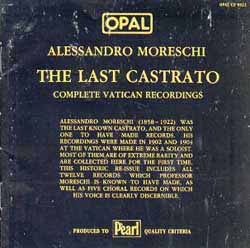 It
was changing musical tastes—nineteenth-century romanticism's dedication
to real human passion—rather than moral qualms, which brought
about the decline of the strange, sad figure of the castrato. By the
early decades of the 1800's they were no longer in demand, although
an occasional aberration would turn up, such as Wagner (in 1880!) originally
insisting on a male soprano for the role of Klingsor in Parsifal. In
1903 Pope Pius X finally and officially forbade the "cultivation" of
the white voice. Again, moral qualms apparently played no part; Pius'
edict declared that much contemporary church music of the day was simply
too modern, including such massive orchestral works as Verdi's Requiem.
He wanted a return to the simplicity of the Gregorian chant. With
that, the castrato faded into obscurity, even within the confines of
the Roman Catholic church. The last castrato in the Vatican Chapel was
Alessandro Moreschi (1858-1922). There is even a recording* of him (photo,
CD cover), witness to one of the more bizarre sidelights in the history
of music. It
was changing musical tastes—nineteenth-century romanticism's dedication
to real human passion—rather than moral qualms, which brought
about the decline of the strange, sad figure of the castrato. By the
early decades of the 1800's they were no longer in demand, although
an occasional aberration would turn up, such as Wagner (in 1880!) originally
insisting on a male soprano for the role of Klingsor in Parsifal. In
1903 Pope Pius X finally and officially forbade the "cultivation" of
the white voice. Again, moral qualms apparently played no part; Pius'
edict declared that much contemporary church music of the day was simply
too modern, including such massive orchestral works as Verdi's Requiem.
He wanted a return to the simplicity of the Gregorian chant. With
that, the castrato faded into obscurity, even within the confines of
the Roman Catholic church. The last castrato in the Vatican Chapel was
Alessandro Moreschi (1858-1922). There is even a recording* of him (photo,
CD cover), witness to one of the more bizarre sidelights in the history
of music.
[Interestingly,
there are male sopranos that are not eunuchs. They are termed "sopranista"
and composers such as Rossini wrote parts for them after the real castrato
went out of fashion. Their vocal range is apparently due to some hormonal
anomaly. They still perform today; a prominent such performer is Simone
Bartolini, an Italian who specializes in the Baroque repertoire.]
*"Moreschi,
The Last Castrato." Pearl Opal CD 9823. Pavilion Records, Wadhurst,
England.
|
